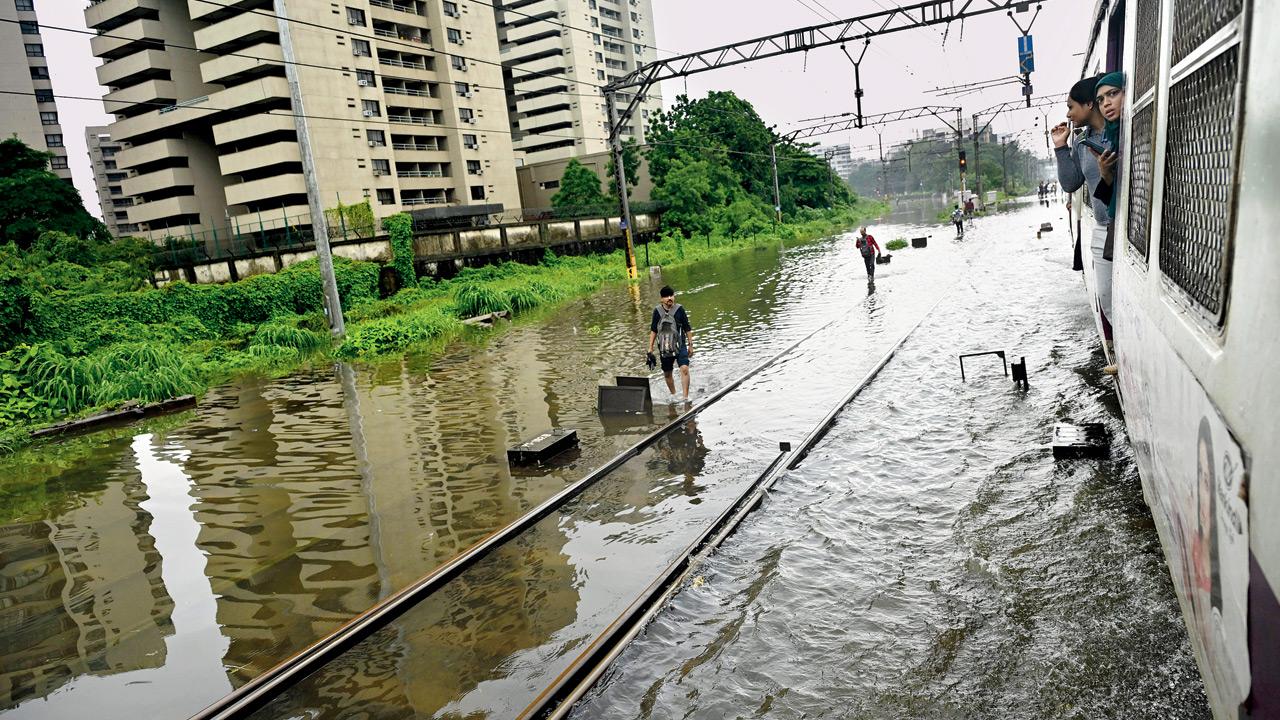The world’s largest flood water diversion facility with 70-metre tall cylindrical tanks could be replicated at critical sites along Mumbai’s railway lines

A commuter wades through flooded railway tracks during the monsoon last year. File pic/Atul Kamble
In what could be a permanent solution to Mumbai’s railway flooding problem, the Mumbai Railway Vikas Corporation (MRVC) has proposed a study on flood assessment and mitigation measures, exploring the Japanese model of underground holding ponds. These ponds could store water during high tides, preventing waterlogging once and for all.
Tokyo’s Metropolitan Area Outer Underground Discharge Channel (MAOUDC), known for its massive ‘floodwater cathedral,’ is an engineering marvel completed in 2006 after 13 years of construction. It is the world’s largest floodwater diversion facility, featuring enormous 70-metre-tall cylindrical tanks. If approved, similar systems could be implemented at critical locations along Mumbai’s railway network. This study is part of the Mumbai Urban Transport Project (MUTP) 3B and may be included in MUTP 4 for execution.
ADVERTISEMENT

Central and Western Railways have been working on micro-tunnelling to drain floodwater
“No one can completely stop Mumbai from flooding due to its terrain. Waterlogging happens during high tide and recedes within four to five hours when the tide lowers. The idea is to hold this water temporarily by creating large underground holding ponds beneath the tracks, similar to Tokyo’s model,” said Vilas Sopan Wadekar, Chairman and Managing Director of MRVC.
He added that IIT had conducted a similar study for the BMC, leading to its implementation at low-lying areas like Bharatmata Junction and Hindmata. “We have comparable low-lying spots along railway tracks where this method could work,” Wadekar explained.
 Flooded railway tracks between Kurla and Sion last year. File pic/Atul Kamble
Flooded railway tracks between Kurla and Sion last year. File pic/Atul Kamble
The most flood-prone sections are between Churchgate-Virar, CSMT-Kalyan, and Wadala-Vashi, with around 50 locations requiring intervention. A hydrograph and simulation study will determine how much water accumulates in five hours, helping identify the most critical spots. Instead of immediately draining the water into nullahs or drainage systems, it would be stored in underground tanks and released once the tide recedes. “This approach saves land and space, as multi-storied structures can be built above these tanks. It’s an innovative solution,” Wadekar added.
Existing measures
Central and Western Railways have been working on micro-tunnelling—underground channels beneath the tracks—to drain excess water. Western Railway has also conducted topographical studies on flooding to improve drainage efficiency.
CR waterlogging spots
Masjid Bunder, Sandhurst Road, Matunga-Dadar, Chunabhatti, Sion, Kurla, Bhandup, Tilak Nagar.
WR waterlogging spots
Dadar, Matunga, Mahim (Harbour Line), Bandra (Harbour Line), Andheri (Harbour Line), Vasai Road.
What is floodwater cathedral?
Japan’s floodwater cathedral is a crucial part of the Metropolitan Area Outer Underground Discharge Channel (MAOUDC), an advanced flood control system protecting North Tokyo. This massive underground network features a series of tunnels and towering cylindrical reservoirs designed to manage large volumes of water, showcasing remarkable engineering. At the heart of the system is one of five colossal, 70-metre-tall storage tanks—large enough to fit a space shuttle or even the Statue of Liberty. These tanks are linked by a 6.3 km network of underground tunnels, allowing efficient water diversion during heavy rainfall.
 Subscribe today by clicking the link and stay updated with the latest news!" Click here!
Subscribe today by clicking the link and stay updated with the latest news!" Click here!







